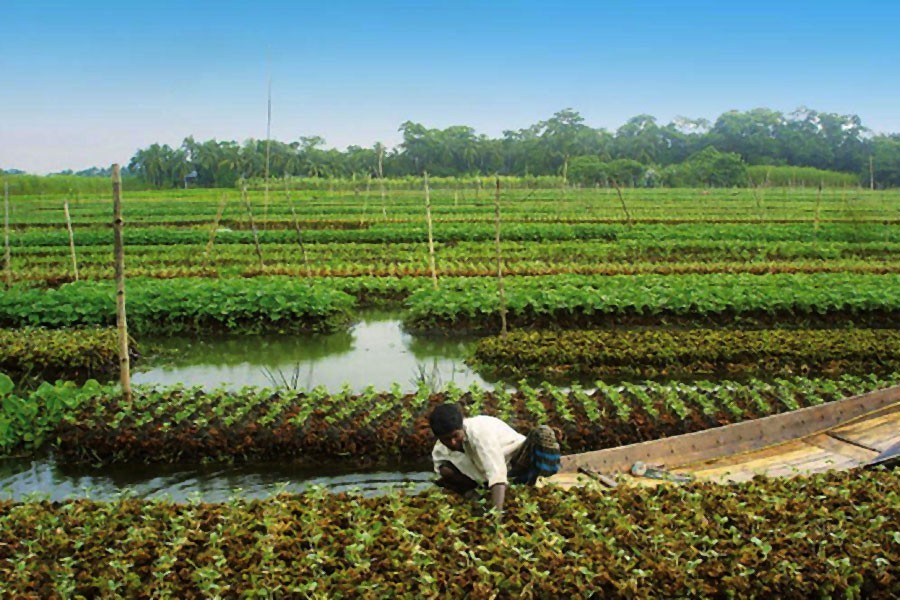This is the dry season. Low lands, canals and countless water bodies all across the country now look arid, even baked in places from the scorching sun rays with very little moisture in the air. The rivers (but for the major and the mighty ones) are also barely any better than narrow, muddy trickles. The landscape will change in months with the advent of the monsoon; and the downpours -- incessant or not -- will have vast swathes of parched lands dripping wet, leading to even flash floods in some areas.
Given the recurrence of floods as an annual phenomenon, particularly in low-lying areas, preparedness to protect crops and human habitats has to be a regular affair. There are identified locations in the country where such preparedness is most crucial. Schemes/projects are also in place, and all that is required is a well-coordinated effort among the relevant agencies to get to business well in time. Failing to do so has been the cause of colossal damage to standing crops and untold human misery on many occasions.
One may recall the flash floods in 2017 that caused havoc in the greater Sylhet and Mymensingh districts. Observers attributed the unwarranted calamity to the authority's failure to implement a well-targeted project titled 'Pre-monsoon Flood Protection and Drainage Improvement in Haor Area'. The project was a well designed one with components meant to particularly address the situation in the low-lying haor belt of greater Sylhet and Mymensingh. Given that the haor belt is highly vulnerable to flash floods and that there are some unique features too in the way floods affect the livelihood of millions of people living in the areas, the aforesaid project was supposed to be a milestone in controlling flood waters. Costing over Tk 7.0 billion, the project was meant to protect nearly 30 upazilas of Sylhet, Sunamganj, Moulvibazar, Habiganj, Kishoreganj and Netrakona from monsoon flooding. Thirty-six of 52 haor areas under the project were in Sunamganj. It was found that progress of the project got snagged due to many hurdles, which among others included non-disbursement of funds, lack of adequate manpower to execute and monitor progress of work, and indeed, alleged lack of seriousness on the part of the implementing agency-the Bangladesh Water Development Board (BWDB). It was commonly believed that had the works been done as scheduled and designed, people in the large swathes of the haor belt could have been protected from the deluge. Equally importantly, their main crop could have been saved.
Despite the shocking experience of 2017, there is still a lack of coordinated approach, according to media reports, to get on with a number of flood protection and embankment projects in the flood-prone region. Reports say work on many of the schemes/projects could not be started as yet in Sunamganj district -- the worst-hit district of 2017 flooding. It has been gathered that a total of 553 schemes have been selected for execution with a target of protecting the main crop Boro in 11 upazilas under Sunamganj. The total cost has been estimated at Tk 934.7 million for reconstruction and reshaping works on a total of 440 km embankment.
However, the fact remains that implementation of the schemes on time is still uncertain. Project Implementation Committees (PICs), the key responsible bodies in implementing the schemes, have not yet been formed in respect of all the schemes. Work has not yet started, reportedly, in 140 schemes. In view of slow or little progress of work, a local forum 'Haor banchao, Sunamganj banchao' staged a rally a few days back demanding immediate start of work of the crop protection embankments so that these could be completed by February, the deadline set by the authorities. Large sections of people inhabiting the region which is known as the major producer of Boro in the country fear crop damage in the months ahead, if works are not fast expedited.
Repairing, maintaining and building flood and crop protection embankments, particularly in the haor belt of the country are a decades-long activity. Once funded by the UN's World Food Programme, the works currently run by the government's own funding are often subject to bureaucratic tangles, and despite strong public awareness, the slack work culture appears to hold back implementation of the schemes according to plans. There is weakness in local-level planning - in the functioning of the PICs -- which also seriously affect the progress of work. These are the issues that are flagged time and again to put things right, but any noticeable change in the work culture seems still in waiting.
The embankments in the haor belt are more than flood-protection devices. The fact that these are more for crop protection, that too in a region which produces a significant portion of the country's staple, must hasten actions to ensure that things are set right well in time. The recent media reports, particularly the one in the FE, have highlighted the urgency of the task. The rest depends on how the authorities respond -- hopefully to avoid repetition of the 2017 deluge.


